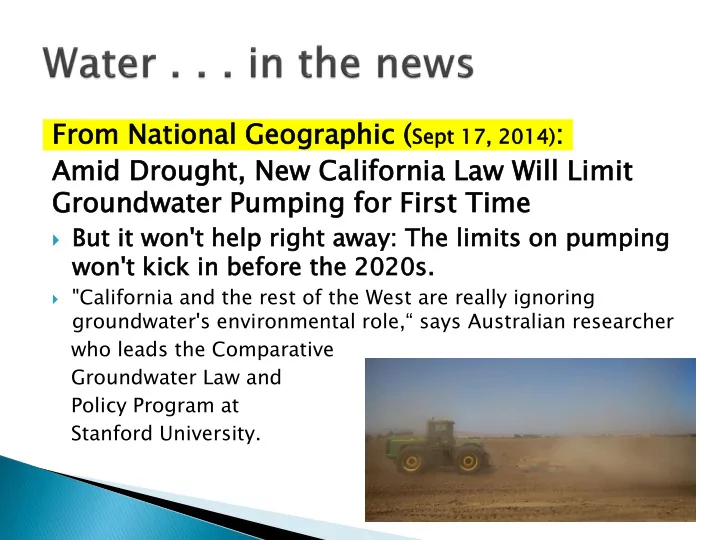

From m Na National nal Geo eographic graphic ( Sep 014) : : ept 17, , 2014) Amid Droug ought, ht, New w California ornia Law w Wi Will Limit Ground oundwater water Pu Pumpin ping g for First st Time But it won't 't hel elp right ht aw away ay: Th The e limits ts on pumping mping won't 't kick ck in before ore the 20 2020 20s. "California and the rest of the West are really ignoring groundwater's environmental role,“ says Australian researcher who leads the Comparative Groundwater Law and Policy Program at Stanford University.
Groundwater the invisible resource Groundwater in Canada Technical discussion of groundwater Groundwater pollution
View ew of f Earth h fr from om Mars Grou oundw dwat ater er On n Earth th : • Small ll but t inte tegra gral part t of hydrol rologic ogical cycle cle •Within 1 km of earth’s surface • Esti timat mated volu olume me of groun undwat water er is 4.2 4.2 mill llio ion n km 3 Compared red to: to: • 125,000 5,000 km km 3 fresh eshwate ter r lake kes • 1,250 250 km km 3 in strea reams ms ‘the invisible resource’
Groundwater supports 98 % of freshwater readily available to humans US – 50% of population (37% of irrigation) Canada – nearly 30% of population Vulnerability: Just 1 1 litre litre of gasoline can contaminate 1 1 million lion litres es of drinking water
Groundwater in Canada
Extent of Glaciation
How is groundwater formed? What does geology play in the movement of surface water into groundwater settings? How does groundwater interact with surface water? What methods are used to measure the movement of groundwater? How are groundwater quantities quantified?
To Topic c On One: Groundwa undwate ter r Hydrolo rology gy
To Topic c Tw Two: Re Rech charge ge Potenti tential al
Bottling of artesian springs is worldwide UNICEF reports consumption was non- existent in 1950s: Grew to 3.2 billion litres in 1984 then 11.2 billion litres in 1997 Now, 50 billion litres/year (about 30 bl in USA) N early half of bottled water is not “ springwater ”.
To Topic c Th Three: Porosity osity and Permea meabili ility ty
To Topic c Four: r: Th The Groundwa undwate ter r Cycl cle
To Topic c Five: e: Human an Influen fluences ces to Groun undwater dwater Sys ystem tem
Water r supply is the provision of water for different types of human use, such as drinking, domestic use, irrigation and urban-industrial supply. Two basic problems are related to the balance between demand and availability and the quality of water: 1. Supply is dependent on the physical principles of the hydrologic cycle 2. Demand is related to the density of population.
Thapa apa, , 2001 01
Groundwater Pollution Groundwater pollution occurs when waste products or other substances change the chemical or biological characteristics of the water and degrade water quality so that animals, plants or human uses of the water are affected. plant nutrients Bacteria, viruses Pesticides, herbicides hydrocarbons (including petrol and oil) heavy metals and other toxic chemicals.
Point source pollution livestock watering Irrigation aquaculture (fish farms) Mineral/hydrocarbon extraction Urban Run-Off Human Error (toxic spills) Diffuse pollution
SEPTIC SYSTEMS
SMALL DISPOSAL PITS
HOUSE AND GARDEN CHEMICALS
STREAM INFILTRATION
DE-ICING SALTS
LANDFILLS
STORAGE LAGOONS
UNDERGROUND STORAGE TANKS
FERTILIZERS
LAND APPLICATION OF SLUDGES AND WASTE WATER
PESTICIDES
HAZARDOUS MATERIALS
TRANSPORT AND TRANSFER SPILLS
PIPELINES
WELLS
INACTIVE MINING SITES
ANIMAL LOTS
URBAN RUNOFF
CONSTRUCTION EXCAVATION
CEMETERIES AND EXCAVATION
NATURAL SUBSTANCES
Aquifers provide 30 - 40 % of the state's water supply in normal years but close to 60 % in drought years. On the edges of the Central Valley, where aquifers are relatively shallow, municipal wells are running dry, forcing small towns to import water at excruciatingly high prices. Many groundwater-fed surface streams have been depleted, threatening the species that depend on them. Over the past decade NASA satellite research has shown that Central Valley farmers are withdrawing groundwater far faster than rain and snowmelt can trickle through soil and rock layers to recharge aquifers. Recent deep and extended droughts, including the current one, have worsened the situation. More extreme weather events such as drought are occurring with CLIMATE CHANGE.
The impacts of climate change are profoundly affecting water resources and their management. World leaders are meeting in New York City on September 23, 2014. This past weekend people around the world gathered to send politicians a strong message that action on climate change is needed now. Over 300,000 people were in Manhattan including: Dr. Paul Berger, LU Faculty of Education and Jason MacLean, LU Faculty of Law and they will be our guest speakers on Thursday
Recommend
More recommend